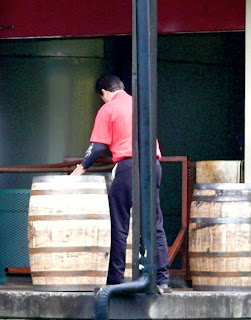In certain parts of the country, sale of products containing alcohol is heavily regulated. In fact, there are even some counties in some states that are "dry" -- no alcohol is sold at all. Anywhere, anyhow. Outlets, whether stores, bars or restaurants, simply do not exist. Nada. Well what's an old wino to do? No wine? Basta!
I assumed Kentucky would be different. Or at least that purchasing opportunities would be consistent across the state. After all, when you hear the word "Kentucky," what comes to mind first? Tobacco? Horse racing? Jim Beam? All of the above?
The alcohol laws vary throughout the state, and it's almost impossible to keep up with its "diversified" regulations. Interestingly, most counties in Kentucky are still dry -- of 120 counties, just 31 are "wet." Then there are "moist" counties, where liquor can be sold only under certain circumstances, in specified locales. BUT.....then there are "wet" cities in "dry" counties. And there can be "dry" precincts in "wet" cities and counties. Huh? And "dry" cities in "moist" counties. And then there are the "Exceptions." Exceptions can include "QUALIFIED" golf courses, historic sites and (DUH!) tasting venues in wineries and bourbon distilleries!
So when I saw the sign for "Chuck's" in Bowling Green (right across the street from my WalMart roost for the night), I ventured forth to check out Kentucky's wine selection. Think "BevMo" with some novel marketing ploys.
It had a walk-in beer "closet"...
You could watch TV in the gin and vodka aisle...
You could taste wines ("Tres Leches" is considered a "wine" in Kentucky!) from an assortment of vintners...
Didn't bring your own glass? No problem...
Munch on cheese and crackers...
Meet interesting people and pick up strangers...

Check out peculiar brews...
Or make your selections at the drive-through, pick up window and never leave the comfort of your car!!!
~~~~~~~~~~
On to the hard stuff...
Some distilleries do "cute"...
The first distillery I visited (after driving umpteen miles on a twisty-turny, back-country road without shoulders, barely wide enough for the trucks and me to pass each other) -- Baja revisited -- had no area large enough for RVs to park.
So, on to Heaven Hill Distilleries that did have generous RV parking. I visited the museum, bought a little black cat lapel pin (it was October), eschewed the tour and tasting and learned all I needed to know about bourbon from the museum displays and dioramas. Ready?

After it's been distilled, the "white dog" is stored (aged) in NEW, charred white oak barrels. It's not considered bourbon until it has been "influenced" by its container -- usually in about two years. It entered the barrel as clear and colorless as gin. After seven years, the whiskey has started to soak into the barrel, has turned a deep caramel color and has the oaken taste with "vanilla undertones of classic bourbon." The charring of the barrel is what gives it its amber color. At this point, about a third of it has evaporated.
The barrels are warehoused in buildings many stories high called "Rick Houses." I call them "barrel prisons." The average rick house will hold 20,000 or more barrels. Bourbon ages differently in different rick house locations. For example, barrels located in the outer perimeters or near the top of the building are more exposed and thus more sensitive to seasonal temperature variations. Barrels in middle and bottom rows tend to age slower.
After twelve years, bourbon has evaporated and been absorbed by the wood even more until just a tad more than 50% of the original liquid remains. Distillers call that other, evaporated loss, the "angels' share" because of the fine vapors that have floated heaven-ward! (Sounds like an Irish fable, huh?) Well, there's the reason 12-year old bourbon costs more!!
















